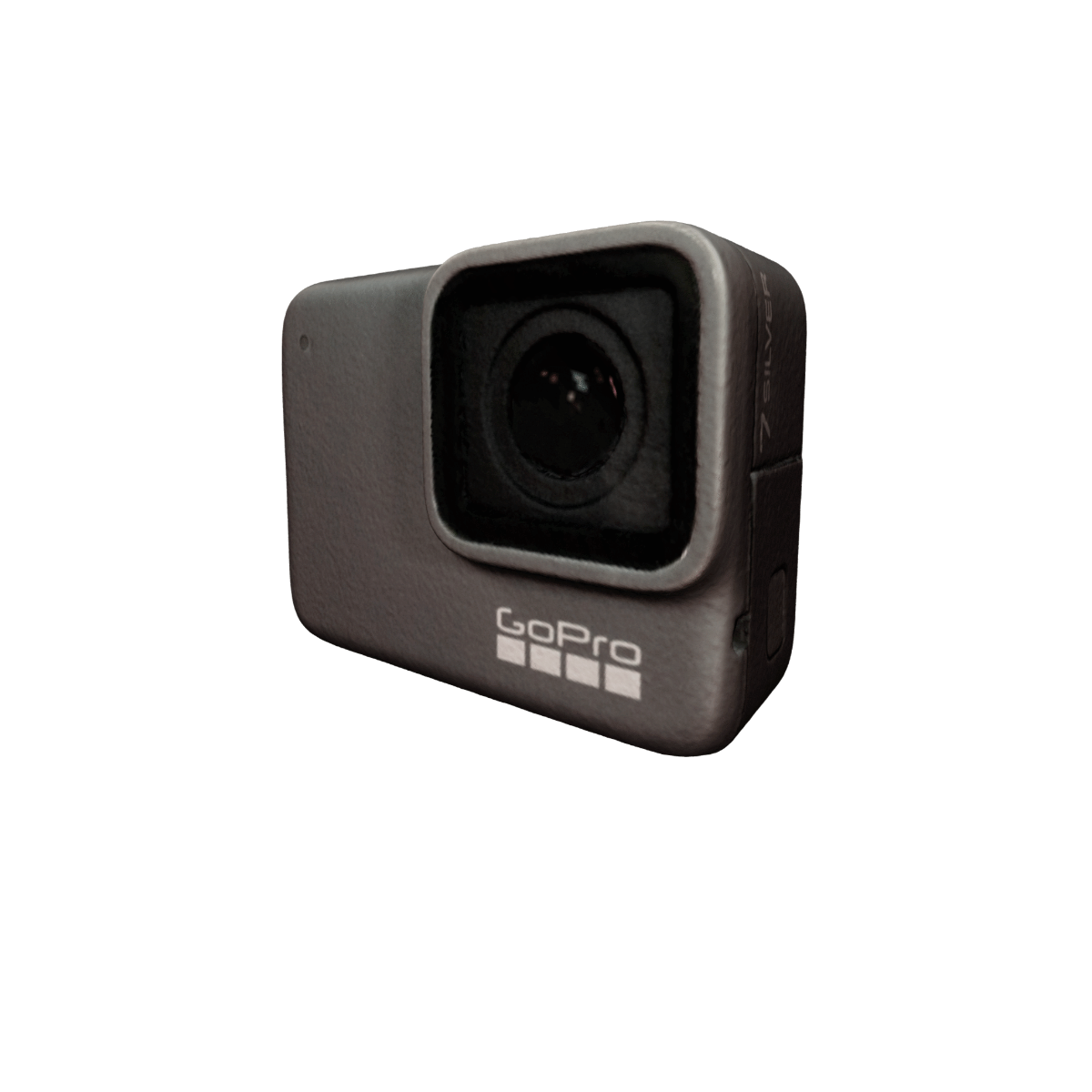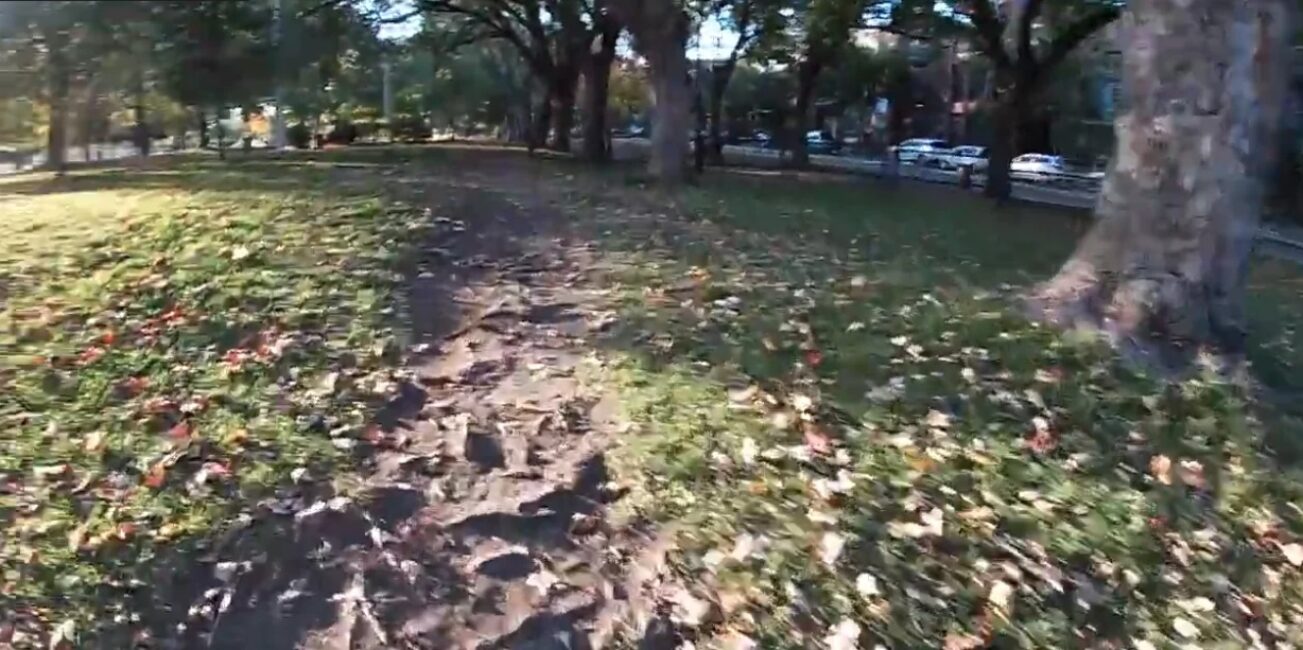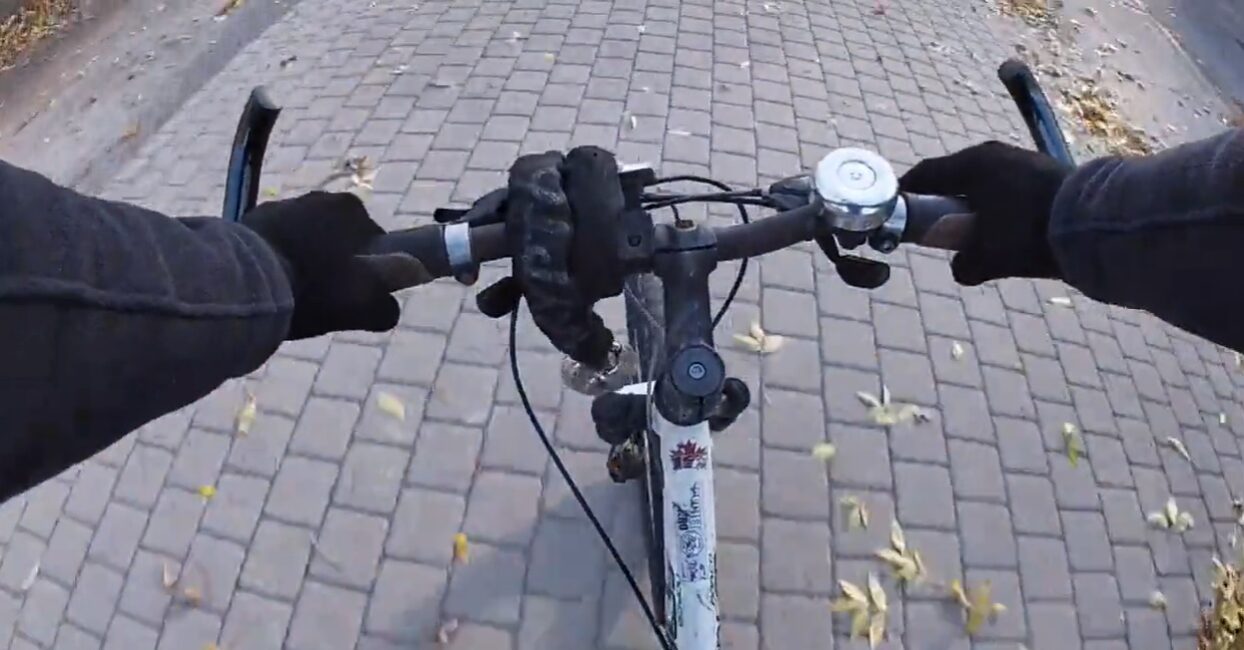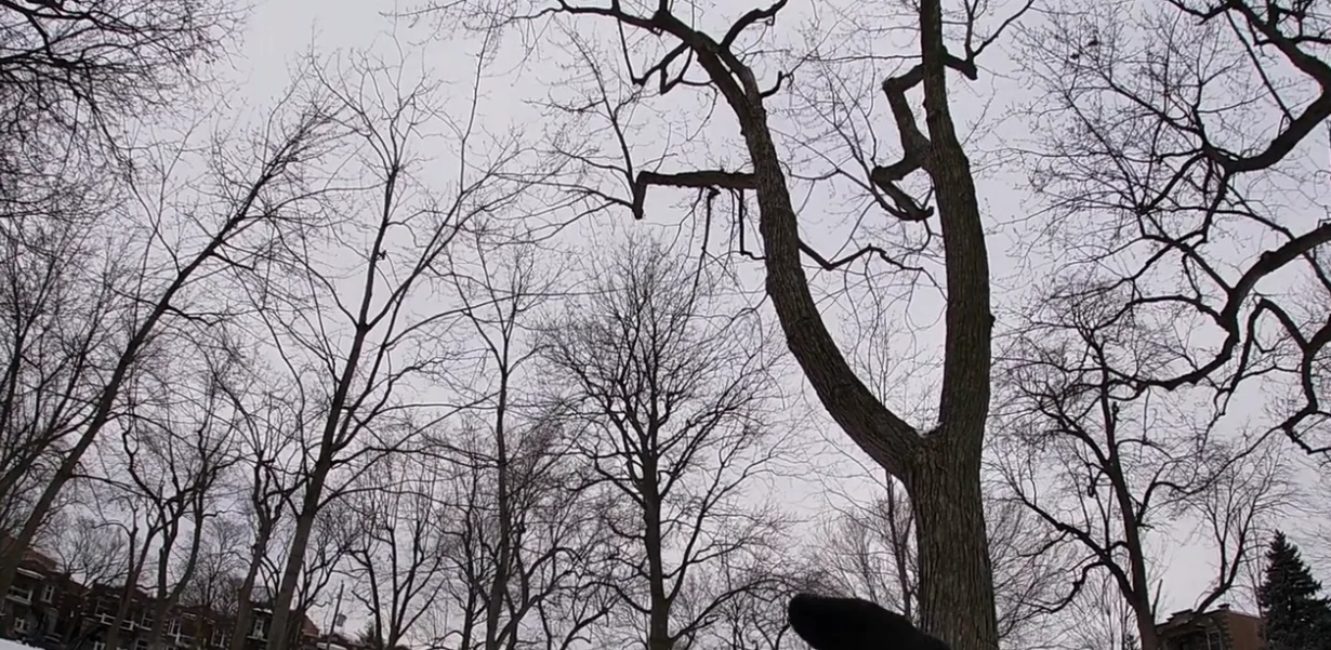GoPro
A small camera that fits in: Portability for athletes
2005
The GoPro is an extremely small (6 cm x 4.5 cm x 3 cm) and light (94 grams) camera whose lens, sensor, memory card and microphone are all enclosed in a tough outer case. It was invented by a surfer who wished to record his exploits without being hampered by a camera. Thanks to its easy handling, it quickly became popular not only with its target market—athletes—but also with travellers and filmmakers!
Refer to the “Additional resources” section to see a glossary of technical terms.
The GoPro and sports
The GoPro was not the first wearable compact, easy-to-use camera, nor was it the last! Many other models soon followed. As with all “action cameras,” its primary function is to serve as the extension of a body in motion and to record athletes’ exploits without getting in the way. It can be mounted on the body using accessories suited to different sports and activities.
There is no need for athletes to frame and focus their shots; the camera simply needs to be mounted on the body and it will record whatever is in front of it, even in extreme conditions. And thanks to its large storage capacity, it can record long sequences without interruption.
The points of view it provides convey its proximity to the body, while the action shots it records amplify the athlete’s movements, allowing viewers to experience them as well.
A few videos shot with the GoPro
Workout at Laurier Park
Cinémathèque québécoise
A runner works out at Laurier Park in Montréal on a beautiful fall afternoon. He records his activity using a GoPro HERO7 Silver. At first, the camera is mounted on his chest with a harness; it is subsequently mounted on his forehead.
Arguably the most famous of “action cameras,” the GoPro is designed to be an extension of a moving body and to record the athlete’s acrobatics without hinering his or her movements. It attaches to the body with the help of accessories adapted to the athlete’s needs and the sport itself.
At the beginning of the activity, the GoPro is at the runner’s chest level. The runner’s arms can be seen and his breathing can be heard. His exertion is experienced through the camera’s close proximity to his body. The camera sways continually from side to side.
It is an unusual point of view. Normally, a runner’s head remains relatively stable, otherwise nausea would likely ensue. Nevertheless, in this position, the camera doesn’t hamper the runner, who can move freely.
When the camera is later mounted on the runner’s forehead, it provides a more natural point of view.
Workout at Laurier Park
Cinémathèque québécoise
A runner works out at Laurier Park in Montréal on a beautiful fall afternoon. He records his activity using a GoPro HERO7 Silver. At first, the camera is mounted on his chest with a harness; it is subsequently mounted on his forehead.
Arguably the most famous of “action cameras,” the GoPro is designed to be an extension of a moving body and to record the athlete’s acrobatics without hinering his or her movements. It attaches to the body with the help of accessories adapted to the athlete’s needs and the sport itself.
Note: The information in square brackets describes the audio and visual content of the clip. There is no dialogue or narration in this video.
[1:09 minute sequence.]
[Outdoors. Laurier Park. Colour.]
[The sequence is comprised of a series of exercises filmed with the camera mounted first on the athlete’s torso, and then on his forehead. The shots are therefore from a subjective, first-person point of view.]
[The sounds of the runner’s breathing and footfalls.] [A man is running along a pathway in a park. His hand occasionally appears at the bottom right of the frame. There are colourful leaves in the trees, and the sun casts a warm glow over the scene. The camera sways from right to left in sync with the runner’s strides and arm movements.]
[The runner continues down a shaded pathway lined with trees. He turns right, rounds a bench and heads for a grassy area. In the background, behind the trees, cars are moving along the street. The camera continues to sway from side to side.]
[The image is jolted up and down as the athlete does a sidestep run. View of an expanse of grass, similar to the one in the previous shot, and a picnic table. Trees line the background and the right side of the frame. The runner’s momentum can be felt.]
[Cut to another view.] [The sounds of the wind and the runner’s breathing.] [View of a set of arched monkey bars and the runner’s forearms. Trees can be seen in the background; there is a lamppost on the right. The runner’s two hands are now grasping one of the bars as he does pull-ups. The camera is at his head level, so it moves up and down, above and below the bar. When it is below the bar, the metal structure of the apparatus and its setting in the fitness circuit become visible.]
[Cut to another view. The runner has turned around. He grabs the bar again, pulls himself up and continues to do pull-ups. The camera captures the colourful trees and the blue sky. Below the bars, there is a patch of hard-packed dirt.]
[Crossfade.] [Background sounds of the park, beeping machinery and the runner’s breathing.] [View of an expanse of grass, strewn with dead leaves, in the park. In the distance, a path crosses the space and trees frame it. The runner sits down on the grass, then lies back. The camera films his arms, legs and feet as he moves. There is a brief glimpse of another person with him. When the runner lies down, the camera points up toward the sky. The treetops form a circle. The runner gets back onto his feet, breathing hard. The other person appears briefly in the frame.]
[End of scene.]
Bike ride
Cinémathèque québécoise
A cyclist goes for a ride around Montréal. At first, he records his bike ride using a GoPro HERO 7 Silver mounted to his chest with a harness; he later mounts it to the front of his helmet.
This video of a bike ride demonstrates the importance of selecting the right accessories for each activity. For example, in this clip, when the camera is mounted on the cyclist’s chest, it shows nothing but the bike frame and the front wheel. The field of view is very limited because the GoPro is in a static semi-downward position. The point of view is that of the cyclist’s chest, not that of the cyclist. The bike itself becomes a character in the video. When the camera is later mounted on the cyclist’s helmet, it records almost everything the cyclist sees. The viewer becomes immersed in the video and shares the cyclist’s experience. Also, the jolting of the camera due to potholes is corrected by the image stabilization system. The cyclist does not need to make adjustments to the camera because its settings are automatically adjusted.
Bike ride
Cinémathèque québécoise
A cyclist goes for a ride around Montréal. At first, he records his bike ride using a GoPro HERO 7 Silver mounted to his chest with a harness; he later mounts it to the front of his helmet.
Note: The information in square brackets describes the audio and visual content of the clip. There is no dialogue or narration in this video.
[1:32 minute sequence.]
[Indoors. Stairway inside a building. Colour. All shots are from a subjective, first-person point of view.]
[Sound of footsteps in the stairwell.] [A flight of white stairs. Movement toward a glass door.][Sound of the door being opened.][The cyclist’s arm enters the frame to open the door. He is now in the vestibule. A row of mailboxes can be seen on the right. In the background, there is a glass door on the left and a windowpane on the right. Through the window, a row of parked cars can be seen.]
[Outdoors. A street in Montréal. Colour. All shots are from a subjective, first-person point of view.]
[The cyclist unlocks the padlock on his white bicycle.][Metallic sound of keys in the padlock.][When he looks downward, his arms and legs become visible in the frame. He wraps the chain around his handlebars and closes the lock. There is a lawn in the background. Behind it, a brick building.]
[Cut to another view.][Street scene.][The cyclist dons his gloves. On the right, there are other locked-up bicycles, as well as brick buildings. On the left are the parked cars and, in the centre, the sidewalk continues straight ahead.]
[Ellipsis.][Sounds of the bicycle and of cars in the middle distance.] [The cyclist pedals his bicycle. Only the top of the bike frame, the handlebars and the cyclist’s arms and legs are visible. The sounds of passing cars, people talking and children playing in the distance can be heard.] [Ellipsis.][The cyclist veers right and descends onto a bike path. The acceleration of the bike and an increase in bicycle and wind noise mark this change. Two bicycles pass the cyclist on the left. Only their wheels can be seen.]
[The sounds of the wind and the moving bicycle.] [The camera is now mounted on the cyclist’s forehead. The cyclist arrives at a downtown intersection. The camera turns to the left and to the right, following the cyclist’s head movements. The cyclist then proceeds forward. Another cyclist passes, going in the opposite direction.][Jump cut. The cyclist is now on a different bike path. He looks at his handlebars, then lifts his head and glances to the right. The camera follows all his head movements.]
[End of scene.]
Winter workout
Cinémathèque québécoise
A man enjoys a snowy winter run in a park.
The sounds of the runner’s muffled footsteps, his breathing and the metallic clicking all feel very close. The runner films his activity with ease and is not hampered by the device. Once again, the image stabilizing software keeps the image smooth. Also, the camera’s resistance to cold is demonstrated.
Winter workout
Cinémathèque québécoise
A man enjoys a snowy winter run in a park.
Note: The information in square brackets describes the audio and visual content of the clip. There is no dialogue or narration in this video.
[1:57 minute sequence.]
[Outdoors. A park in Montréal. Colour. All shots are from a subjective, first-person point of view.]
[The sounds of the runner’s breathing and footfalls. An occasional metallic clicking sound. The runner heads straight for the far end of a park. He runs through an expanse of snow in the middle of the park. Behind the leafless trees, homes can be seen.]
[Crossfade. The athlete continues to run, now heading toward the other end of the park. He slows his pace for a few steps and walks toward a bench. In the background, cars are moving along the street. He turns around to sit down and the camera follows the movement. Once the runner has sat down, treetops fill the frame of the camera. On the very edge of the frame, the runner rubs his hands together.]
[Crossfade. The athlete now runs along the edge of the park. He turns right and accelerates. His hands move in and out of the frame rhythmically.] [The sound of running intensifies.]
[Jump cut.] [The runner approaches a series of wooden arches and passes underneath them. Because the structure is low, he must bend forward to enter it. The camera therefore shows his legs and the ground. Once he is through the obstacle, he begins to run again. In front of him is a landscaped area.] [Jump cut.] [The runner runs past a small plastic tunnel. He goes around it and then enters it, shimmying on his back. The camera films his arms and legs. As he moves through the tunnel, only his breathing and the squeaking of his footwear against the plastic can be heard. The camera films the roof of the plastic tunnel from the inside. Once out of the tunnel, the athlete begins to run again. A sign reads, “Volcano Island, Children Only.” The athlete returns to the arches, this time from the other end. He bends down again to go through them. Once again, the camera films his legs and the ground. Fade to black.]
[End of scene.]
The origins of an invention
The development of the GoPro represents another step in the miniaturization of digital cameras. This ongoing process began 30 years ago, when manufacturers began searching for ways to create compact digital cameras. Several models were developed and the gradual transition toward digital photography began. For example, in the 1990s, many filmmakers used mini camcorders.

Still frame from the 2000 film The Gleaners and I by Agnès Varda. The director films herself holding her MiniDV.
© Ciné-Tamaris
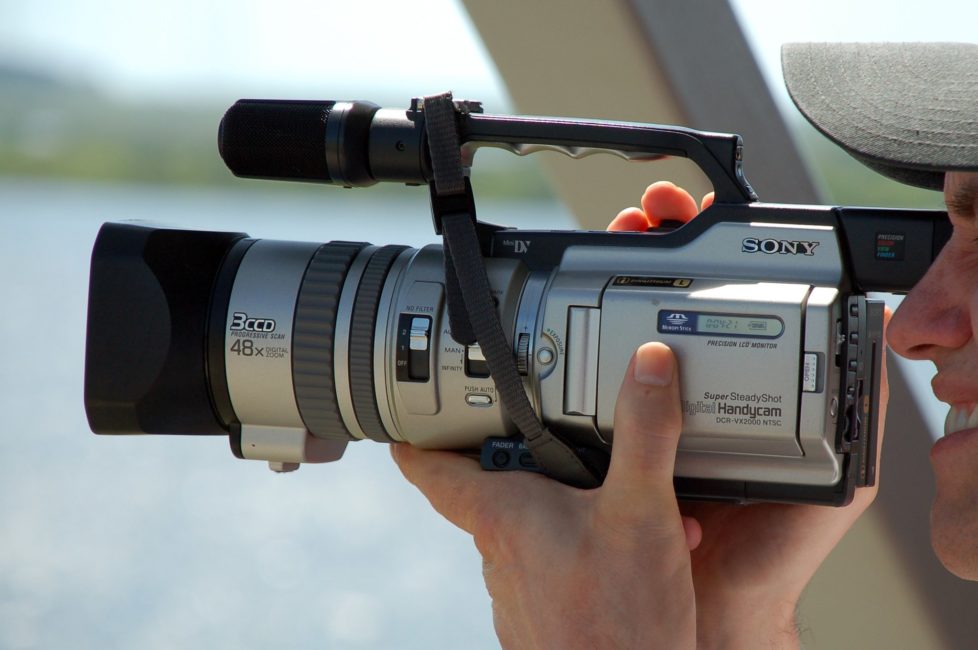
Photograph of a man using a SONY MiniDV Handycam digital camera.
Nabukodinosaure CC BY-SA 4.0
For a long time, filmmakers searched for ways to bring cameras as close to operators’ bodies as possible, to allow viewers to share and experience their activities. Many cameras that were not designed to be worn the body were therefore equipped with accessories that allowed them to be used as extensions of the body. Before the GoPro, many athletes searched for ingenious ways to strap video and film cameras to their bodies. Skydiver André Suire and his helmet camera are a good example of this. Nevertheless, these heavy devices were not very practical.
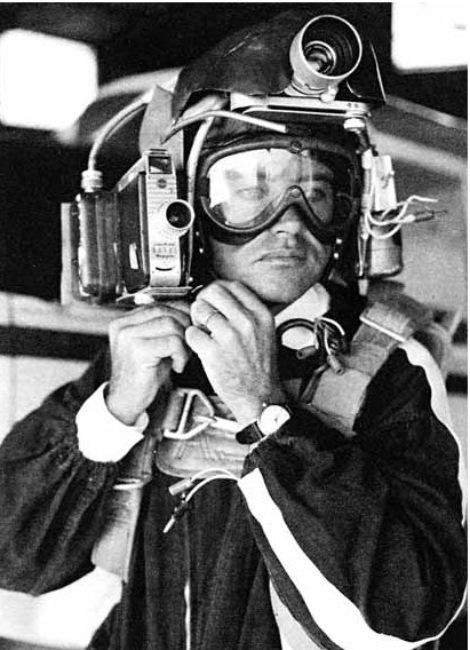
Anon. 1963. “Letters .” American Cinematographer, vol. 44, p. 692. Skydiver André Suire with two cameras fitted to his helmet.
Public domain
Video archive of a 5,000-metre freefall skydive in 1961. The electronic camera designed for this feat was used a bodycam. The dive was broadcast on television.
The GoPro narrows the distance between the camera and the athlete’s body. Amateur surfer Nick Woodman, the creator of the GoPro, wanted a camera he could use while surfing. In 2002, he founded his company in the U.S.

The very first GoPro camera, the GP HERO, with its wrist strap. This camera was equipped with a viewfinder to frame shots. Viewfinders were later replaced by screens.
© Philippe Bédard
The first 35 mm photographic camera developed by Woodman had a production cost of $3 USD and sold for $30. However, it didn’t quite meet his needs. He went on to develop a new version that could record video, did not have a viewfinder and could be mounted anywhere on the body. The GoPro company logo features a row of four squares that represent the four main uses of these cameras. The first square, on the left, denotes extreme land-based sports like motocross and cycling. The second square from the left symbolizes surfing. The third, darker square refers to underwater sports and the white square on the right represents winter sports.

Photograph of Nick Woodman in 2014 holding a GoPro camera.
cellanr – CC BY-SA 2.0
The first digital GoPro was launched in 2005. In 2020, the GoPro HERO7 Silver sold for about $270 CAD.
This tough, compact action camera is equipped with rugged waterproof housing. It can be mounted on helmets, surfboards and hockey sticks, as well as on chests and almost any other part of the body. Most models feature wide-angle lenses, offering a wide field of view and infinity focus. They include electronic features such as video stabilization software.
The GoPro meets three major needs for recording a body in motion: It is compact, lightweight and easy to operate.
GoPro technical data sheet
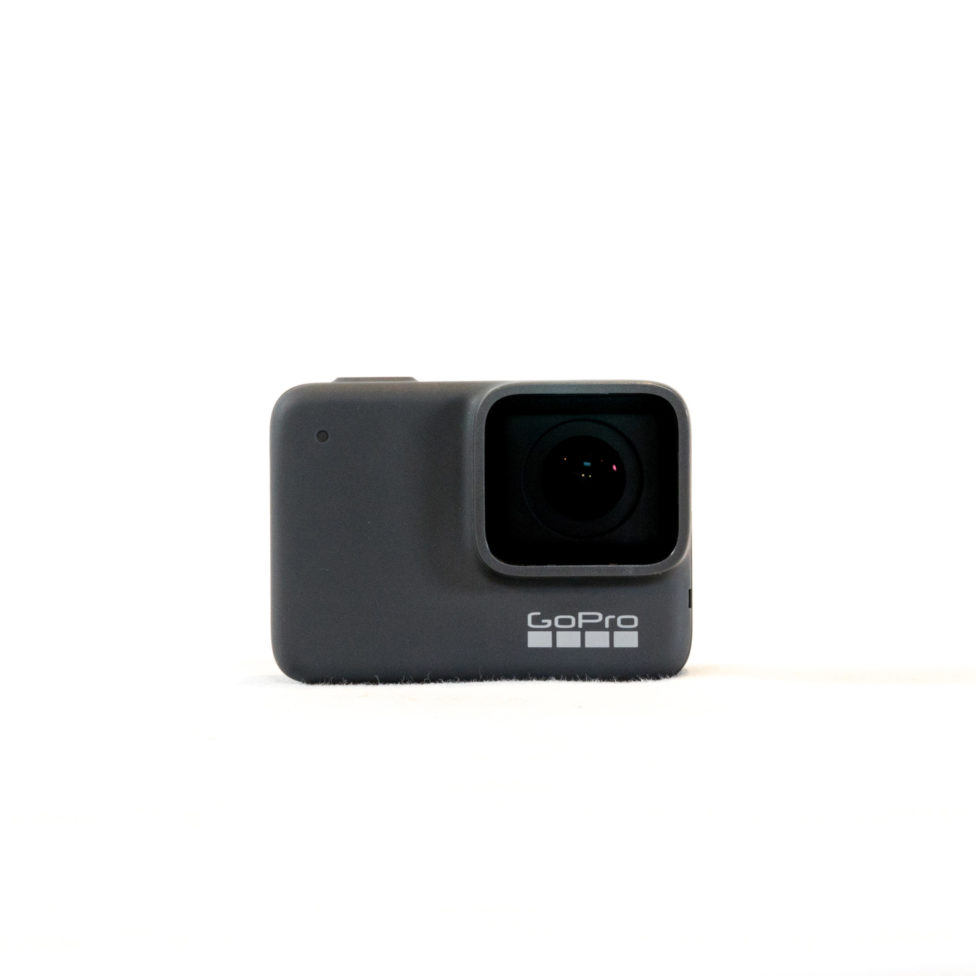
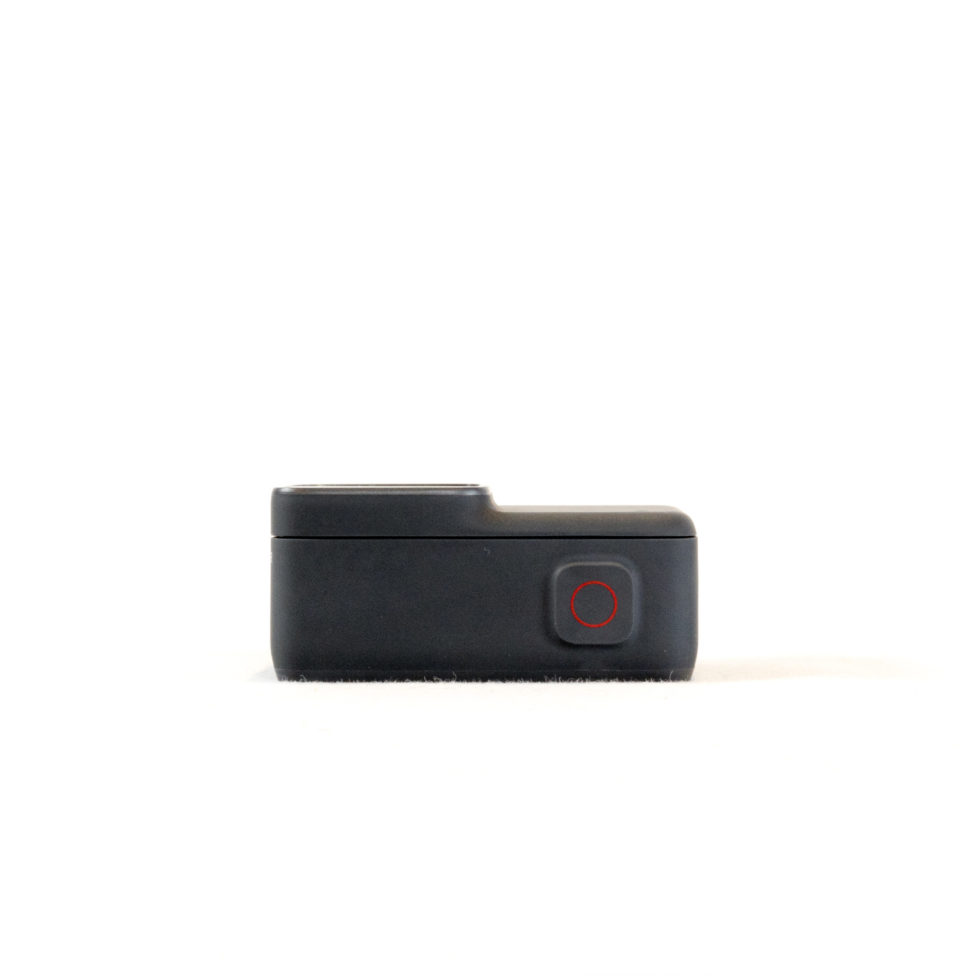

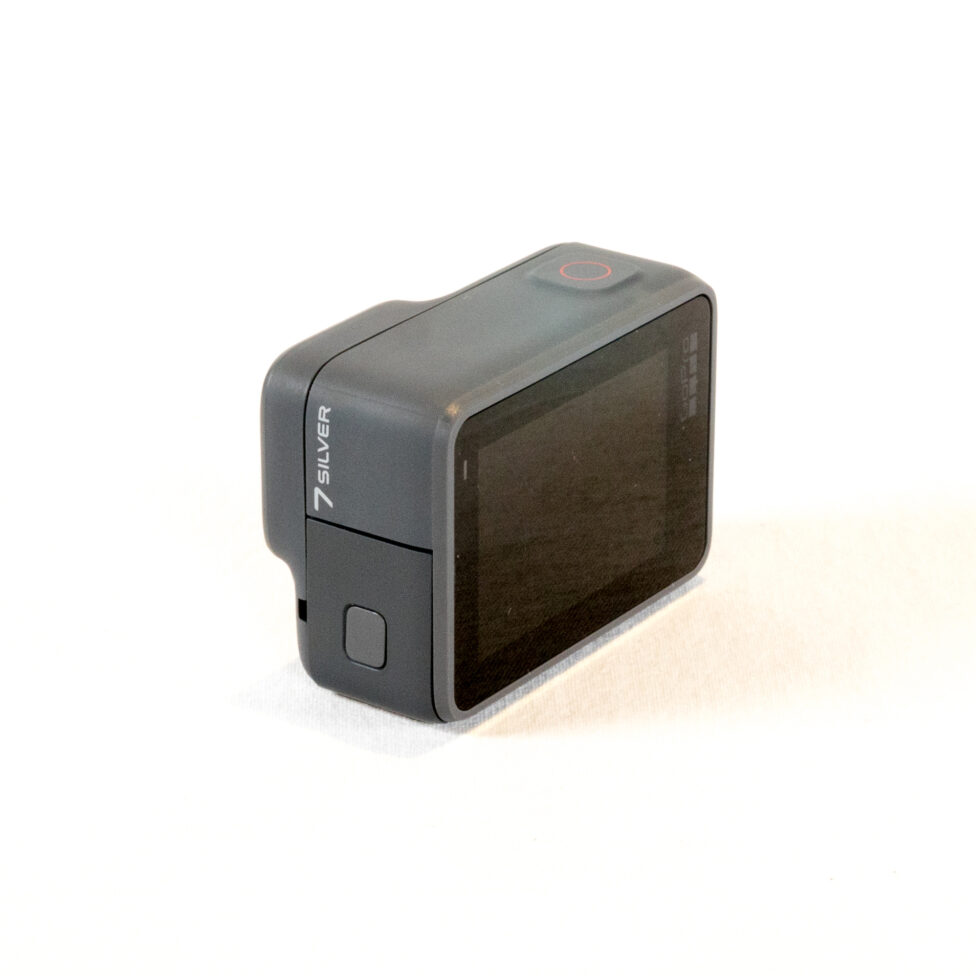
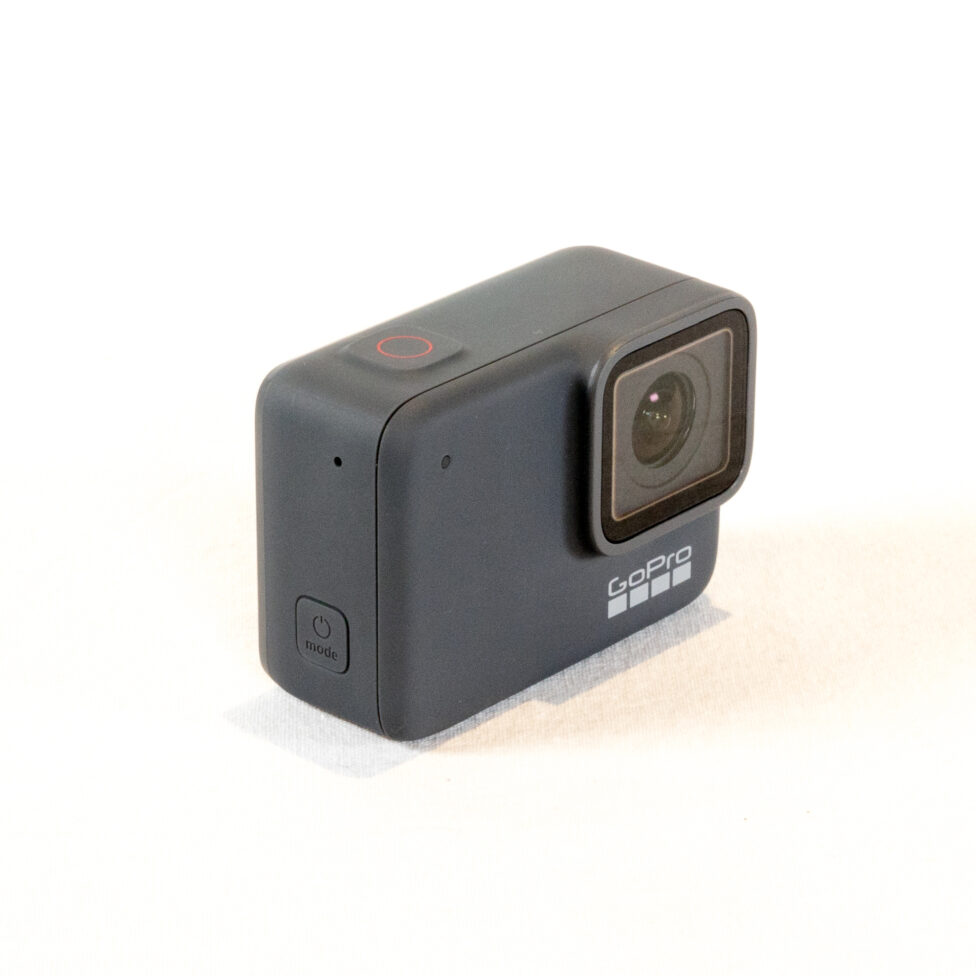
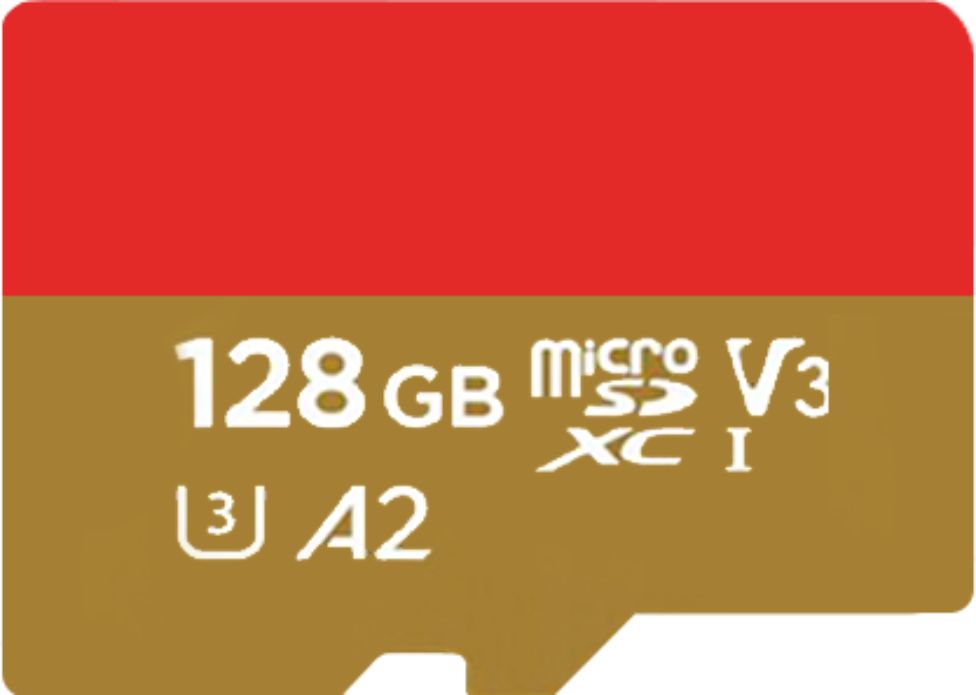
The following specifications apply to the GoPro HERO7 Silver, which is the mid-range model of the seventh-generation GoPro. Its simple functions make it accessible to amateur users.
Specifications
- Measurements
- 6 x 4,5 x 3 cm
- Weight
- 94 grams
- Materials
- Plastic
- Frame rate
- 30 or 60 frames per second
Components and accessories
- LCD screen
- The LCD screen has several functions. It is used to navigate the camera’s menus and settings, as well as to display remaining memory card and battery capacity. It is used for viewing recorded videos, and because the camera does not have a viewfinder, it also serves as a monitor.
- Housing
- The lens, sensor, memory card and microphone are all enclosed in a tough outer case.
- Ultra wide-angle fisheye lens
- The ultra wide-angle lens produces strong visual distortion of anything that is not in the centre of the frame. It also captures vast panoramic views.
- Integrated battery
- The battery has a run time of up to 107 minutes, depending on settings such as resolution, fast motion, slow motion and options used (Wi-Fi, Bluetooth), as well as ambient temperature.
- Memory card
- A Micro SD card with a storage capacity of up to 128 GB. These cards can store up to four hours of footage, making it possible to film long sequences.
- Vertical mounting buckle and thumb screw
- The vertical mounting buckle is used to attach the GoPro to the harness. It has a slightly curved shape, and its angle can be further adjusted once it is mounted on the harness. The thumb screw ensures the camera and its case do not fall off.
- Microphones
- The dual-microphone system is integrated into the body of the camera, offering advanced wind noise reduction.
- Voice command
- When voice commands such as “GoPro, take a photo” or “GoPro, start recording” are uttered, a sound signal confirms that the function has been activated.
Features
- 10-megapixel image sensor
- With wide dynamic range, burst function and scheduled capture modes.
- Three available resolutions
- 1) 4K at 30 frames per second (4:3 ratio). 2) 1440p at 30 or 60 frames per second (4:3 ratio). 3) 1080p at 30 or 60 frames per second (16:9 ratio)
- Time lapse and 2x slo-mo
- Wi-Fi and Bluetooth
- With the popularity of Youtube, camera connectivity is a major selling point. The company’s 2017 slogan was, “Live the moment. Capture the moment. Share the moment.”
- Geolocation
- Equipped with GPS and accelerometers, the GoPro can instantly display speed, distance travelled and acceleration.
- GoPro apps
- The GoPro camera can be paired with mobile applications and editing software and offers unlimited cloud storage.
- Cutting-edge sensors and algorithms
- Captures smooth, detailed video, no matter the activity.
- Zoom
- Digital zoom that can be used while recording.
- Accessories
- Compatible with over 30 accessories, including mounts for handlebars, surfboards, helmets, tripods, cars, torsos, heads and even dogs.
- Waterproof
- The GoPro is waterproof to 10 metres and resistant to sea water, dust, snow, mud and sand
Operation and handling
The GoPro’s portability and easy functionality provide its users with the freedom and independence they seek.
Before beginning to shoot, the camera’s settings can be adjusted to optimize its performance (for example, sharpness and frame rate). Athletes can select the accessories that suit their needs.
The chest mount harness is one of the many hands-free accessories developed and patented by GoPro since 2004 to attach the camera easily and securely to an athlete’s body. There is little risk of the camera falling off or breaking.
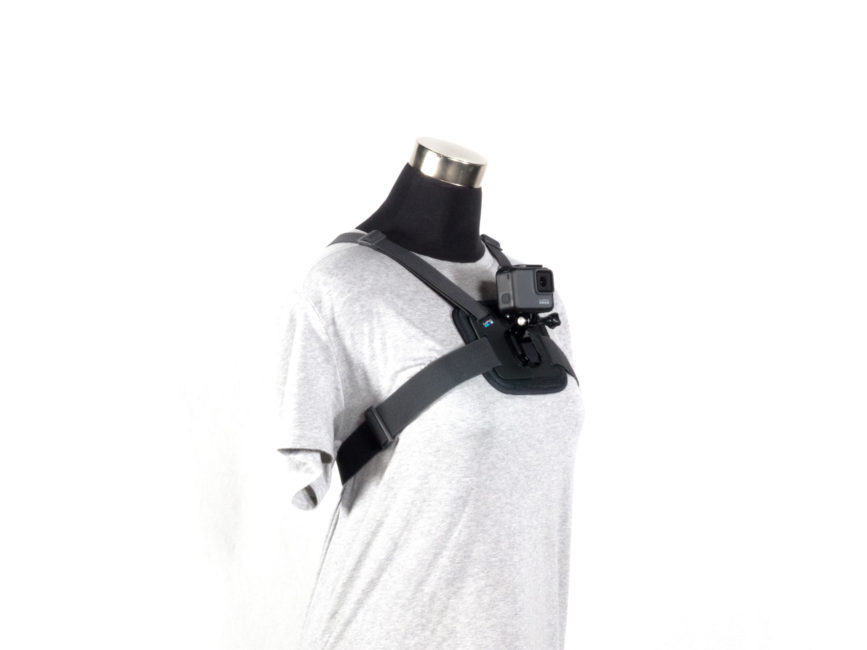
Photograph of a GoPro HERO7 Silver on a chest mount harness.
TECHNÈS – CC BY-SA 4.0
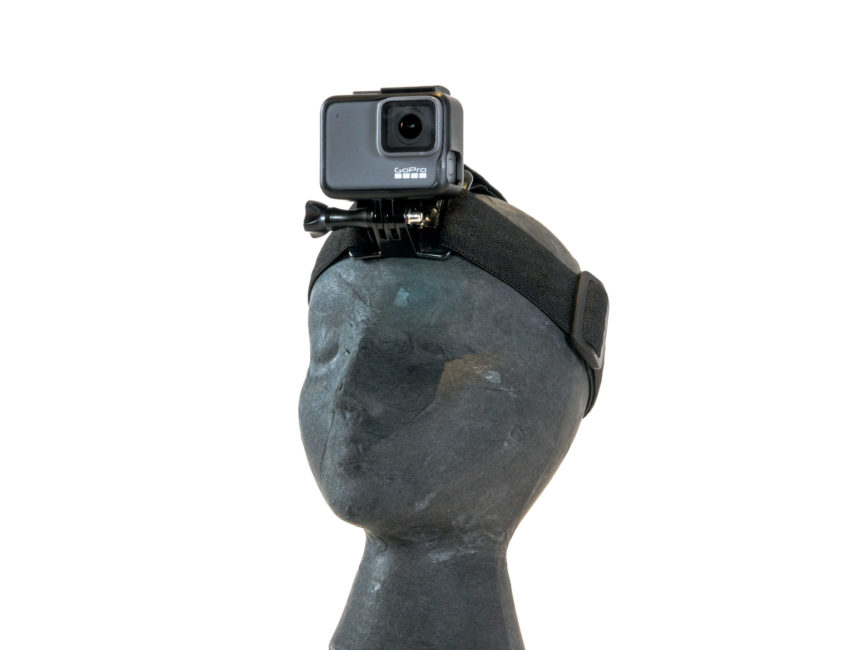
Photograph of a GoPro HERO7 Silver attached to a head strap.
TECHNÈS – CC BY-SA 4.0
Once the camera is mounted, it can be controlled by voice command. The athlete does not need to make any adjustments to the camera while it is recording. Photography skills are not required; however, it is important to consider the types of movements that will be done, in order to select the accessories that will capture the best point of view.
Athletes can view the recorded images on the GoPro’s touch screen, edit them using the GoPro app and upload them to social media in an optimized format to share with their online networks.
The GoPro can therefore be used by a single person from start to finish—from preparation to internet sharing.
Who uses the GoPro?
The initial target market for this camera was sports-minded photography aficionados. Later, it was expanded to include amateurs and adventurous tourists in search of extraordinary landscapes.
To impress potential users, the brand’s advertising videos for models such as the GoPro HERO 7 feature travellers and extreme sports enthusiasts. These advertisements are meant to demonstrate the possible uses of the camera. However, they are produced by professionals using extensive equipment and are edited in post-production. The amateur users they target actually have very little chance of achieving similar results.
When the GoPro became available, extreme sports communities fully adopted the technology, and their members began to upload videos and photos to social media at an incredible pace. By serving as an extension of the body, the camera contributes to the athlete’s performance. Because it is close to the body rather than the eye, it records the athlete’s breathing and movements.
By serving as an extension of the body part upon which it is mounted, the GoPro can provide surprising footage. It is quite unusual to see the world from foot level or wrist height!
When the camera is mounted on a body part (hand, leg, head, torso, etc.), the movements of the entire body are seen from its unique point of view. This alters their appearance, making them look strange.
(Bédard 2021, online).
For example, in this promotional video entitled Sensation, four points of view can be seen via GoPros mounted on the limbs of a hip-hop dancer. Cameras are mounted on his left arm, his chest, his left leg and the bottom of his right foot.

Still frame of a surfer. The GoPro films from a low angle and the wave appears to curve upward toward the sky.
© iStockphoto.com/AleksandarNakic
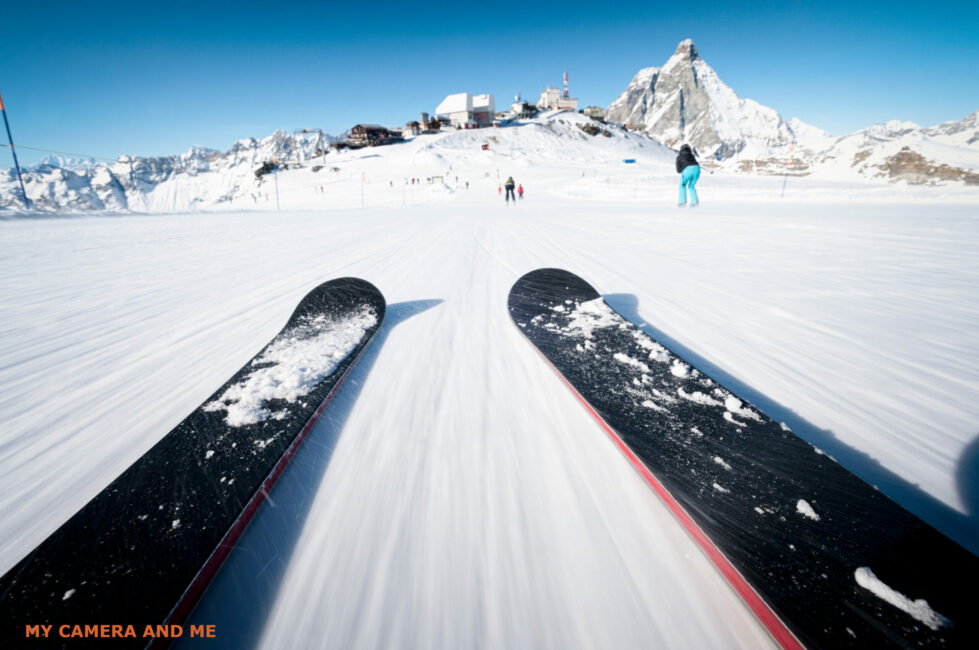
Still frame of a skier. The GoPro is mounted at ankle level. The film is experienced from very low to the ground.
© iStockphoto.com/georgeclerk
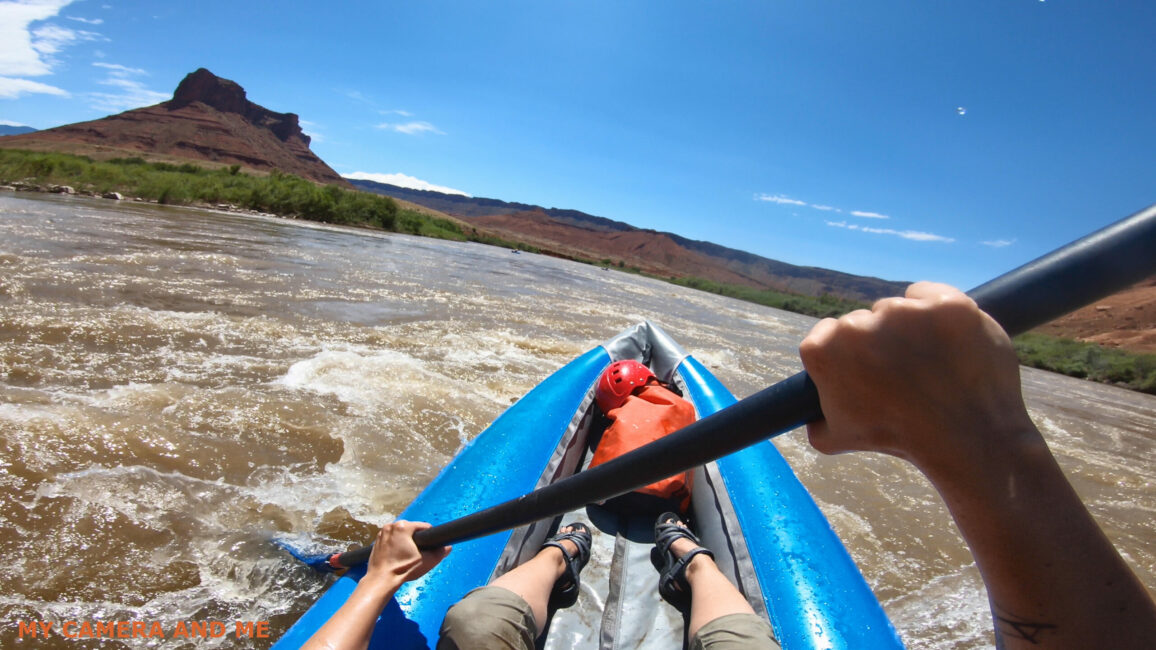
Still frame of a kayaker, taken with a GoPro. The camera appears to be mounted at chest level.
© iStockphoto.com/piola666
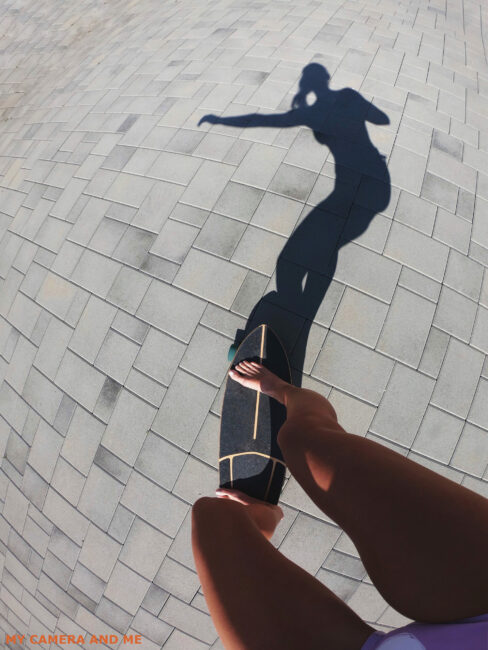
Still frame of a skateboarder, taken with a GoPro. The skateboarder appears to be holding the camera in her hand.
© iStockphoto.com/Taia Planinc
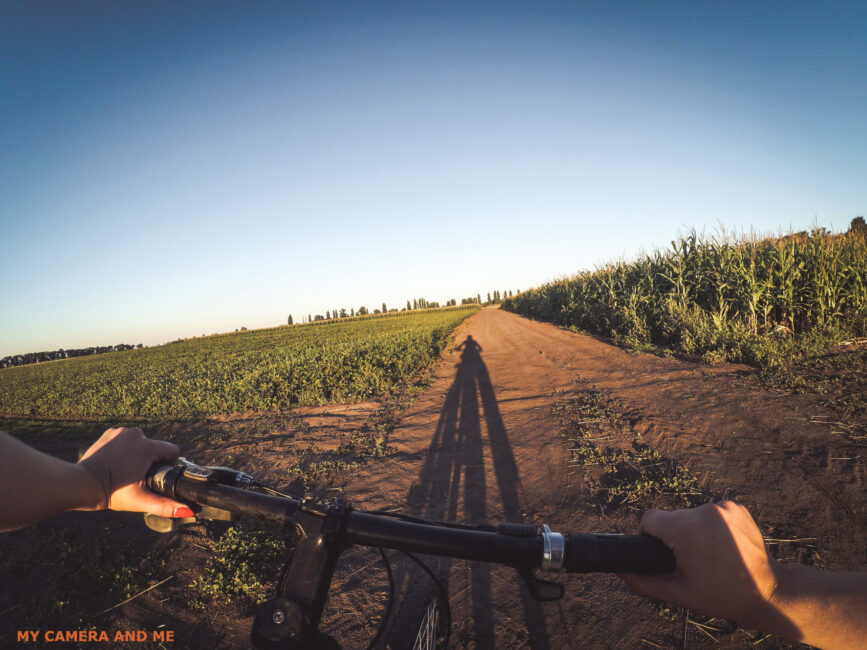
Still frame of a cyclist. The GoPro is mounted at chest level.
© iStockphoto.com/Marina_Skoropadskava
The GoPro appeals to more than just the sports community. It has attracted a variety of users. Since the launch of the first GoPro in 2005, 26 million units have been sold. Its relatively affordable price has made it accessible to a broad range of users.
Professional filmmakers also use these small cameras to film dangerous scenes, for example when there is a risk of the camera being broken.
The GoPro is popular with documentary filmmakers and ethnologists, who recognize that its small size and easy handling make it an unintimidating and accessible tool.
The GoPro appeals to a wide range of users and its versatility allows them to adapt it to their needs.
Additional resources
This motion picture glossary will help you better understand some of the terminology used.
Are you the inquisitive type? Would you like to learn more about GoPro and the athletes who use it? The following website will provide you with additional information.
- Clip from the documentary Leviathan. This film was entirely shot with GoPro cameras.
Bibliography
Bédard, Philippe (Dir.). 2021. “Caméra d’action.” Encyclopédie raisonnée des techniques du cinéma. Under the direction d’André Gaudreault, Laurent Le Forestier and Gilles Mouëllic.
Bégin, Richard. 2016. “GoPro: Augmented Bodies, Somatic Images.” Screens: From Materiality to Spectatorship – A Historical and Theoretical Reassessment. Under the direction of Dominique Chateau and José Moure. Amsterdam: Amsterdam University Press.
Want to find out more?
Take an audio journey into the world of this device.
